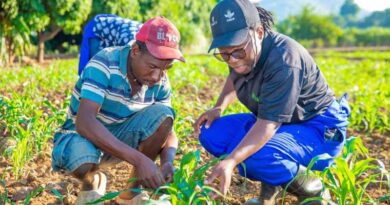Building towards a climate-smart agriculture future through harnessing crop modeling
25 February 2023, Africa: Anticipating appropriate and timely responses to climate variability and change from an agricultural perspective requires forecasting and predictive capabilities. In Africa, climate-related risks and hazards continue to threaten food and nutrition security.
Crop simulation models are tools developed to assist farmers, agronomists and agro-meteorologists with insights on impacts to possible management decisions. Such tools are enablers for taking an appropriate course of action where complexity exists relating to both crop and livestock production. For example, a new variety can be introduced to Zimbabwe, but its performance will differ depending on the agroecological zones of the country and the respective treatments a farmer may apply. Applying modeling tools to assess its performance can predict yield differences and facilitate the generation of recommendations for which region is most suited to the variety, water use efficiency, and crop combinations.
Earlier this month, the International Maize and Wheat Improvement Center (CIMMYT) hosted a crop modeling simulation workshop with delegates from various African countries in Harare, Zimbabwe.
“The CGIAR Initiatives of Excellence in Agronomy (EiA) and Sustainable Intensification of Mixed Farming Systems (SI-MFS) have recognized the need to enhance modeling capacity in Africa to allow African scientists to lead in solving challenges within agricultural systems,” said CIMMYT crop scientist and coordinator of the workshop, Vimbayi Grace Petrova Chimonyo.
The workshop was facilitated by renowned global crop modeling experts to provide critical coaching support to upcoming modelers. These experts included Sue Walker, a professor at the University of the Free State, Tafadzwa Mabhaudhi, a professor at the International Water Management Institute (IWMI), KPC Rao, a lead scientist at the International Crops Research Institute for the Semi-Arid Tropics (ICRISAT), Dirk Raes (KU Leuven), Diego Peqeuno (CIMMYT) and Siyabusa Mukuhlani from the International Institute of Tropical Agriculture (IITA).
Crop models are scientific presentations of statistical knowledge about how a crop will grow in interaction with its environment. They use mathematical equations representing processes within a predefined plant system and the interactions between crops and the environment. The discipline is based on the premise that agricultural system environments are complex and not homogenous. Crop models enable decision-makers to make data-driven decisions by simulating possible outcomes to changes in a system and the configuration of production systems.
“It is quite apparent that modeling skills are scarce on the African continent. This workshop is a step toward consolidating existing capacities on the continent. If we are going to be able to close the already existing food deficit gap on the continent and meet the food requirements needed by 2050, with an estimated global population of nine billion, then we need to take modeling seriously,” said Chimonyo in her opening address at the workshop.
Due to the lack of crop modeling expertise in African states, there is a gap in capacity to build relevant crop advisory tools for farmers at a local level. This leads to poor policy formulation as decisions are based on a high degree of generalizations.
“In this modern era, we need advisories that are context specific. For example, just because a maize variety achieved a certain yield in one context doesn’t mean the same variety will achieve the same yields even if the rainfall patterns are the same. Other factors come into play, such as the soil type, temperature and other related aspects affecting the yield. Crop modeling affords advisory managers some specifications necessary to achieve high yields in different environments,” said Walker.
Speakers at the workshop focused on three models, APSIM, AquaCrop and DSSAT, and participants had the opportunity to take part in activities and ask questions face-to-face. The workshop also covered key modeling aspects such as the minimum data requirements needed to run a model, calibration and validation of models, confidence testing of results, the science involved in simulating phenological development and growth processes, water and nitrogen cycles, and the use of multi-modeling approaches.
The workshop was particularly useful for young scientists, according to Rao, allowing more experienced modelers to share their expertise. “With such an interactive platform, experienced modelers like me can demonstrate multi-modeling approaches.”
Rao presented on two main approaches. The first involved the application of different simulation models to simulate one component of a system such as crops. The second simulated the complete system by integrating various models, such as crops, livestock, and economic models, providing an opportunity to understand the synergies and trade-offs between different components of the whole farm.
Participants at the workshop expressed their satisfaction with the training provided and left with practical knowledge that they could apply in their work both in the field and in the lab.
“When I first arrived, I knew very little about modeling, but as the workshop progressed, my confidence in applying models increased. I intend to immediately apply this knowledge for the forthcoming season such that we can start making impactful contributions to the country’s food and nutrition security status,” said Birhan Abdulkadir Indris, a research officer at CIMMYT.
“I am leaving this workshop with the confidence that I will advise farmers in my circle of influence with services tailored to their needs. I have learned that crop modeling can be used for many purposes and that different models address different issues,” said Connie Madembo, a research technician at CIMMYT. “I intend to teach other fellow PhD students at the University of Zimbabwe the same things I have learnt here. As a country, we need to be at the forefront of using these models, considering Zimbabwe’s high weather variability.”
As a way forward, the trained scientists were encouraged to apply the modeling skills they had gained to address short-term problems such as yield gaps and water use efficiency and long-term challenges such as the local impacts of climate change.
“While more capacity training is required, starting somewhere is better than never starting,” said Mabhaudi.
Also Read: Union Budget 2023: An Overview of the Focus on Agriculture
(For Latest Agriculture News & Updates, follow Krishak Jagat on Google News)















